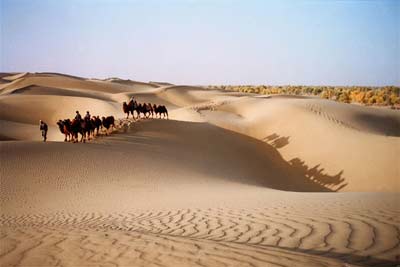| Home / Environment / News | Tools: Save | Print | E-mail | Most Read |
| 18.7 Bln Yuan Earmarked for Anti-Desertification |
| Adjust font size: |
China plans to spend over 18.7 billion yuan in the areas around Junggar Basin, Ebi-Nur Lake Basin, and Tarim Basin in order to hold back the expansion of the Taklamakan Desert and Gurbantonggut Desert, both located in northwest China's Xinjiang Uygur Autonomous Region.
This campaign will span eight years, from 2008 to 2015, covering 58 counties and county-level cities across Xinjiang. The central government will provide 80 percent of the funds for this campaign and the rest will come from the local government, non-governmental organizations, and individuals in Xinjiang. The campaign will be divided into two phases, according to Ismail Tiliwaldi, chairman of the autonomous regional government. In the first phase, from 2008 to 2010, Xinjiang will harness the desertification of 3.43 million hectares of land and improve the condition. By 2015, another 7.6 million hectares will be bettered, of which 1.67 million hectares will be covered by forests. The seriously desertified areas around the three basins at present will be safeguarded by a sound and comprehensive system of prevention and care. Their environment will be improved, and as a result, the expansion of the two great deserts is expected to stop. The Forestry Department of Xinjiang reveals that in the eight years to come, Xinjiang will use both biological and non-biological means to fight against desertification. According to ecological experts, drought, strong wind, and abundance in sand materials are the main natural factors contributing to land desertification in Xinjiang. In addition, a population surge and improperly handled production activities also can accelerate this kind of land deterioration. With desertified land of over 1.8 million square kilometers, Xinjiang is tortured by the most hazardous sandstorms of China. Land desertification directly affects life and production of over 12 million people living in the region. Fortunately, in the last decade, joint efforts by the central government and local people of Xinjiang have effectively slowed the pace of sand's evasion. Now sand can only manage to occupy 1.04 million hectares of land per year, a great decline from yearly 3.84 million hectares in the past. Oases are the only places where people can make a living in Xinjiang. But they occupy only 70,700 square kilometers, accounting for only 4.2 percent of Xinjiang's territory. Embedded among the deserts, they are separated from each other. Forests are rare in Xinjiang. Only 2.94 percent of the whole region is covered by forests. In its oases, forest-covered land only amounts to14.95 percent.
(China.org.cn by Pang Li July 13, 2007) |
| Tools: Save | Print | E-mail | Most Read |
 |
| Related Stories |
|
||||

